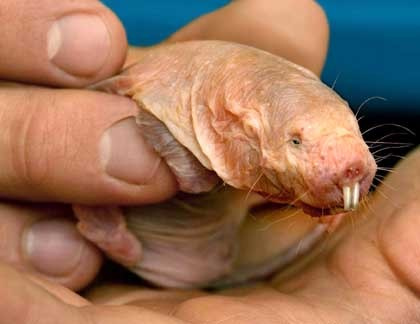The UK landscape, naked mole rat genome and plant pollination tricks
 Termites and biofuel: Mike Scharf from Purdue University and colleagues explored how enzymes found in the guts of termites could be useful in breaking down biomass—that is, branches, leaves and other woody debris—to hasten the production of biofuels. As he said in a recent press release, “For the most part, people have overlooked the host termite as a source of enzymes that could be used in the production of biofuels. For a long time it was thought that the symbionts were solely responsible for digestion…Certainly the symbionts do a lot, but what we’ve shown is that the host produces enzymes that work in synergy with the enzymes produced by those symbionts. When you combine the functions of the host enzymes with the symbionts, it’s like one plus one equals four.” Read more at “Termites’ digestive system could act as biofuel refinery.”
Termites and biofuel: Mike Scharf from Purdue University and colleagues explored how enzymes found in the guts of termites could be useful in breaking down biomass—that is, branches, leaves and other woody debris—to hasten the production of biofuels. As he said in a recent press release, “For the most part, people have overlooked the host termite as a source of enzymes that could be used in the production of biofuels. For a long time it was thought that the symbionts were solely responsible for digestion…Certainly the symbionts do a lot, but what we’ve shown is that the host produces enzymes that work in synergy with the enzymes produced by those symbionts. When you combine the functions of the host enzymes with the symbionts, it’s like one plus one equals four.” Read more at “Termites’ digestive system could act as biofuel refinery.”
UK landscape exposed: The Centre for Ecology and Hydrology published a land cover map of the United Kingdom this week, compiling more than 70 satellite images taken between 2005 and 2008. As Damian Carrington wrote on the Guardian blog, “It takes every scrap of land in the UK, down to a resolution of 25m, and identifies the habitat there. From mountains, heathers and bogs of Scotland to the broad fields of the barley barons of East Anglia, the environmental ‘DNA’ of the nation is revealed.” Read more at “Map lays bare landscape of UK in intimate detail.”
Montana’s oil spill: On July 2, an Exxonmobil pipeline spilled into the Yellowstone River, the longest undammed river in the contiguous U.S. A Nature News article has noted that the ecological damage will be difficult to assess while standing pools of water—caused by recent flooding— remain along the river. According to a recent POLITICO article, Gov. Brian Schweitzer, “who has a master’s degree in soil science, said he’s concerned about the oily sheen that has been spreading over the wetlands, and about the effects of biomagnification as contaminants move their way up the food chain.” Read more at “Flooding complicates Montana oil spill response.”
Naked mole rat’s genome: Joao Pedro De Magalhaes of the University of Liverpool, UK and other researchers have mapped the genome of east Africa’s naked mole rat (Heterocephalus glaber) to explore its anti-aging characteristics. As Michael Marshall reported in a recent New Scientist article, “The mole rats’ long lifespans [they can live up to 30 years] means that, like other long-lived creatures, they must have some means of staving off the harmful effects of ageing. There is evidence that they can rapidly recycle damaged proteins, keeping their systems running at tip-top efficiency.” Read more at “Coolest mammal in the world gets its genome sequenced.”
Pollination tricks: In the below TED video, Jonathan Drori reviews the morphology and coevolution of fascinating plants and their pollinators. He describes one species of Philodendron that uses four times the energy of a humming bird for thermoregulation. By keeping a stable temperature, the flower attracts a species of beetle that prefers to mate at that particular temperature. The flower releases pollen as the beetles mate, and the pollen covered beetles transport the pollen to another flower when they mate again. Read more at “Jonathan Drori: The beautiful tricks of flowers.”
Also, insecticide resistant mosquitoes, collecting whale feces for science, reasons to spend time outdoors, National Parks protection project, ancient flying reptiles, new species in the Philippines and a three ton marsupial.
Photo Credit: Juha Ristolainen